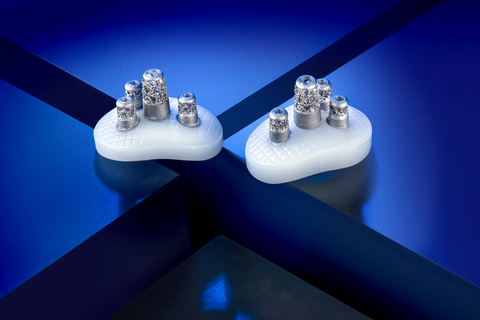
GAINESVILLE, Fla.– Exactech, a developer and producer of innovative implants, instrumentation, and smart technologies for joint replacement surgery, announced successful first surgeries using the Equinoxe® Laser Cage Glenoid, an innovative, next-generation shoulder implant designed to improve glenoid fixation in anatomic total shoulder arthroplasty.
This new glenoid implant, available in standard and augmented options, features a central bone cage and three peripheral cage pegs. Each cage peg is titanium, porous and 3D-printed. First surgeries were performed by Bradley Schoch, MD, of the Mayo Clinic (Jacksonville, Fla.), and Sean Grey, MD, of the Orthopaedic & Spine Center of the Rockies (Fort Collins, Colo.) – two of the product’s design surgeons.
Exactech’s manufacturing process for the Laser Cage Glenoid is unique. Its 3D-printed cage pegs are directly molded to the backside of the ultra-high molecular weight polyethylene (UHMWPE) articular surface, so there is no mechanical locking mechanism. Preclinical testing demonstrated the device successfully withstood cyclic loading at 3,750N (~850lbs) when implanted 5mm proud (simulating a glenoid that is not fully seated) – an extreme loading magnitude and configuration relative to industry standards.1*
“I am impressed by the mechanical strength1* of this unique hybrid design. Mechanical bench testing has demonstrated the remarkable strength of the 3D-printed porous cage pegs, which offer the potential for bone through-growth and better fixation relative to all-polyethylene glenoids,” said Dr. Grey.
The Laser Cage Glenoid builds upon the foundation of the original cage glenoid design, which has been clinically available since 2011. Clinical studies on Exactech’s original cage glenoid have shown that its titanium pegs are associated with a four-fold reduction in the occurrence of radiolucent glenoid lines, as compared to all-polyethylene cemented peg glenoid designs.2 Additionally, the cage glenoid’s wedge augmented design requires less glenoid reaming and preserves more bone than step-augmented glenoid designs.3*
“The Laser Cage Glenoid is provided in multiple sizes of posterior augments, which helps me preserve bone. The wedge-augmented implant design minimizes reaming when correcting glenoid deformity,3 and the porous cage peg design provides excellent initial fixation,” said Dr. Grey.1-3*
Another design surgeon, Thomas Wright, MD, of the University of Florida (Gainesville, Fla.), said, “Exactech is committed to innovation, and this new glenoid implant highlights their intense focus on designing new devices that address unmet clinical needs, like aseptic glenoid loosening, offering the potential for better outcomes for my patients. This new implant is the next generation of a well-proven design with more than 11 years of clinical use, and I am proud to help Exactech bring this important new device to the U.S. market.”
The Laser Cage Glenoid is in pilot launch in the United States. In addition to Drs. Grey, Schoch, and Wright, the surgeon design team includes Stephen Brockmeier, MD, of the University of Virginia Health System, Pierre-Henri Flurin, MD, of the Surgical Clinic of Bordeaux, and Joseph Zuckerman, MD, of the NYU Langone Orthopedic Hospital.

